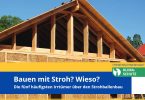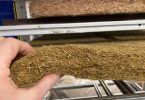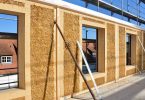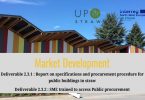Building and insulating with straw is no longer an insider tip for experts. Because the possible uses for the environmentally friendly, cost-effective material have steadily expanded, the Agency for Renewable Resources (FNR) has published an updated version of its brochure “Straw Insulated Buildings”. The first edition was published in 2013.
With the test certificate of the European Approval (ETA) for building straw bales and with the straw building guideline of the German Straw Bale Building Association, the extensive building authority recognition for building with straw is available. These specify the essential properties of straw as a building material and – since 2014 – a comprehensive range of applications. For example, up to three-storey, directly plastered straw buildings can now be applied for and approved in the usual way. Straw can also be used on the outside of masonry and is therefore interesting for renovations. Furthermore, since 2017, building straw bales have achieved building material class E (normal flammability) according to ETA and can be regularly used as a building material. Thanks to the European environmental declarations for building products, figures are also available with which the major environmental advantages of building straw can be presented in a transparent and comprehensible way in terms of ecological balance.
The brochure, now in its fifth edition and supplemented by new building projects, shows that straw is a thoroughly competitive building material. The author, Benedikt Kaesberg, a cultural economist and master carpenter, has been involved in straw construction for many years, from construction supervision and association work to participation in scientific projects.
DE:
Das Bauen und Dämmen mit Stroh ist für Fachleute längst kein Geheimtipp mehr. Weil sich die Verwendungsmöglichkeiten für das umweltfreundliche, kostengünstige Material stetig erweitert haben, hat die Fachagentur Nachwachsende Rohstoffe (FNR) eine aktualisierte Fassung ihrer Broschüre „Strohgedämmte Gebäude“ veröffentlicht. Die erste Auflage erschien im Jahr 2013.
Mit dem Prüfzeugnis der Europäischen Zulassung (ETA) für Baustrohballen und mit der Strohbaurichtlinie des Fachverbandes Strohballenbau Deutschland liegt die weitgehende bauaufsichtliche Anerkennung für das Bauen mit Stroh vor. Darin sind die wesentlichen Eigenschaften von Stroh als Baustoff sowie – seit 2014 – ein umfänglicher Anwendungsbereich benannt. Beispielsweise können bis zu dreigeschossige, direktverputzte Strohgebäude inzwischen auf dem üblichen Wege beantragt und genehmigt werden. Stroh ist ferner auch außen vor Mauerwerk einsetzbar und damit für Sanierungen interessant. Außerdem erreichen Baustrohballen nach ETA seit 2017 die Baustoffklasse E (normalentflammbar) und sind regulär als Baustoff verwendbar. Durch die europäischen Umweltdeklarationen für Bauprodukte liegen zudem Zahlen vor, mit denen sich die großen Umweltvorteile von Baustroh ökobilanziell transparent und nachvollziehbar darstellen lassen.
Die nun in fünfter Auflage erschienene und um neue Bauprojekte ergänzte Broschüre zeigt, dass Stroh ein durchaus konkurrenzfähiger Baustoff ist. Der Autor, der Kulturwirt und Zimmermeister Benedikt Kaesberg, beschäftigt sich von der Baubetreuung über die Verbandsarbeit bis zur Mitwirkung in wissenschaftlichen Projekten seit vielen Jahren mit dem Strohbau.
LINK to Article
LINK zur Broschüre Strohgedämmte Gebäude” (DE)







